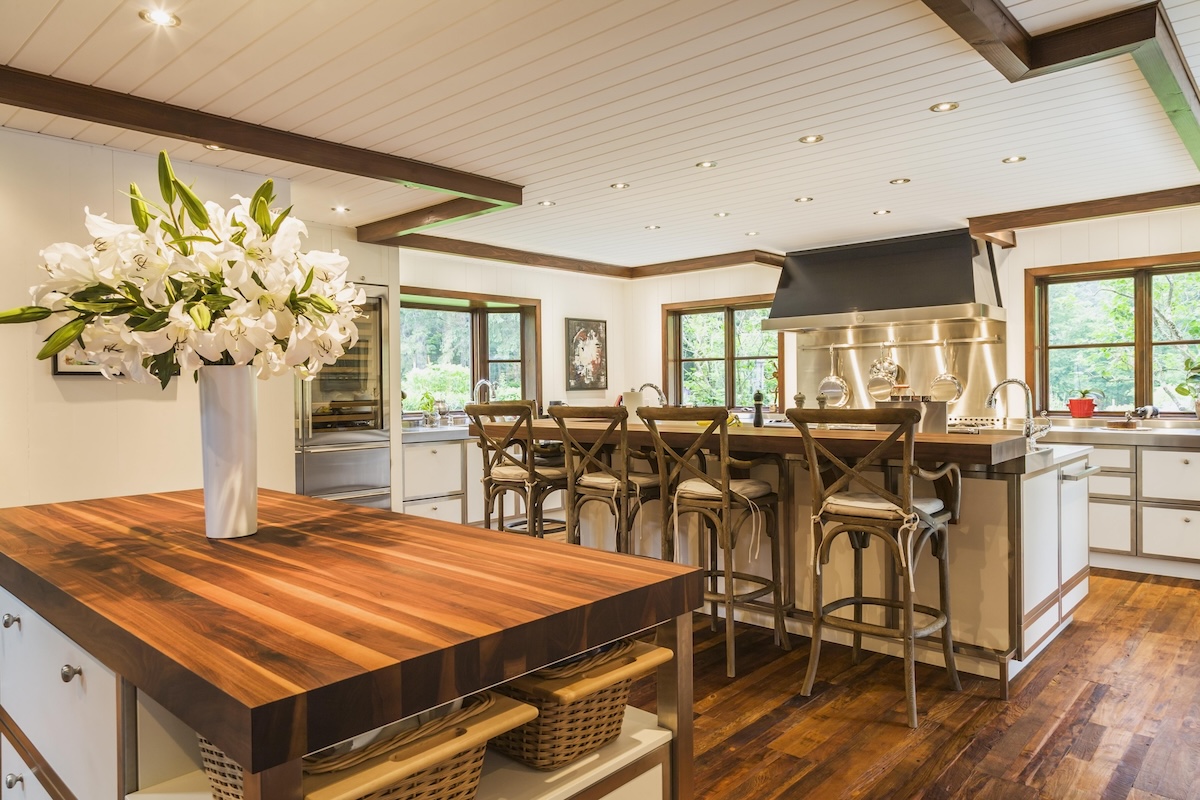

We may earn revenue from the products available on this page and participate in affiliate programs. Learn More ›
“Investing in high-quality countertops can significantly boost the resale value of the home, since the kitchen is one of the focal points for prospective buyers,” says Vicki Zagrodnik, a kitchen and bath designer at Stoughton, Wisconsin-based design and remodeling firm Sims. “The highest return on investment is offered by countertops that are durable, easy to maintain, and offer a timeless appeal.”
All of these factors—plus cost—are important when choosing the best countertop material that suits the way you use your kitchen and how you want it to look. And sometimes it’s not just one countertop. Some homeowners are choosing to mix materials within their kitchen for the look and for functionality.
“Mixing surfaces is a great way to create a dynamic design! Sometimes it’s done for aesthetics, other times, you may also do this with budget in mind,” says Alena Capra, owner of Alena Capra Designs in Fort Lauderdale, Florida. “Pairing a busier stone or porcelain slab with a more monochromatic engineered quartz (or vice versa) brings great balance to a design.”
While there are many types of counter materials that can be used in seemingly endless ways, we’ve narrowed the field to take a closer look at the most popular options, detail their costs, and share where they are best suited so you can pick the best countertop material for the kitchen in your home.
1. Quartz
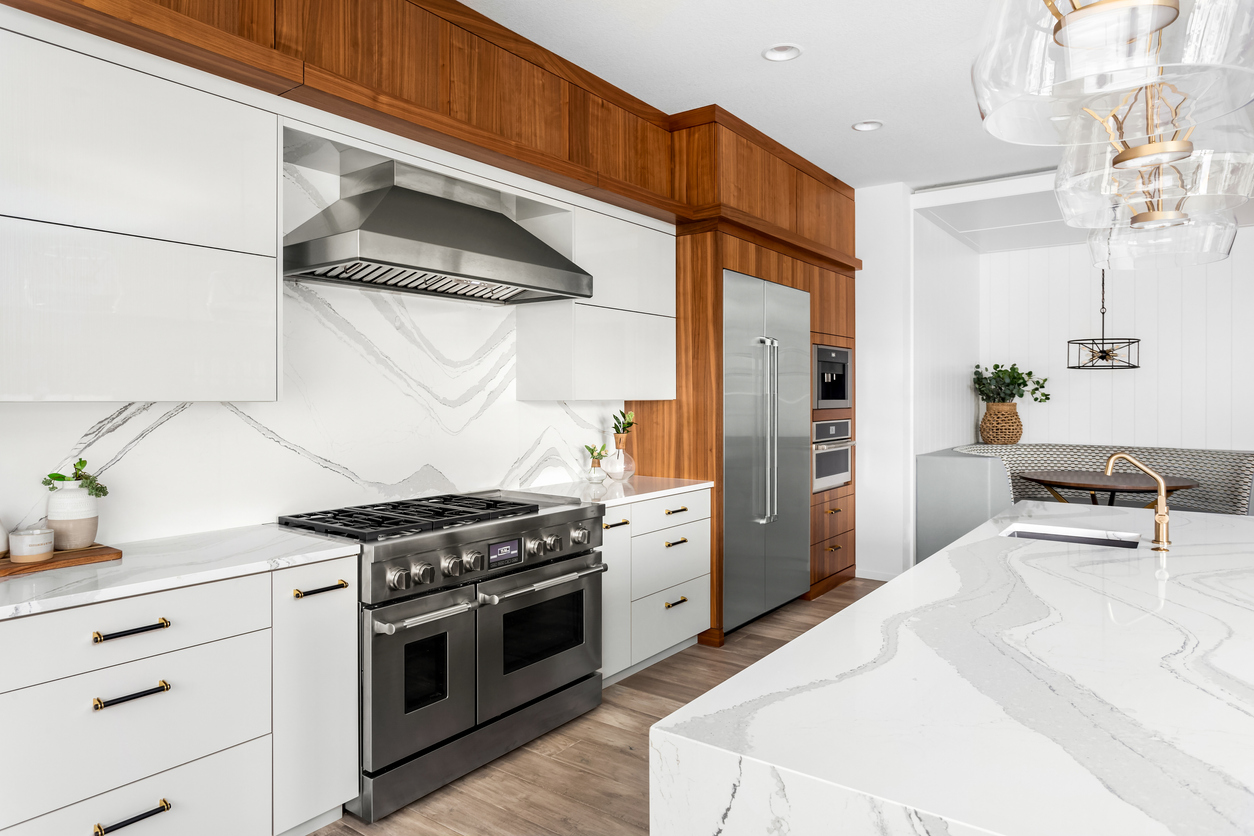
Quartz is undeniably one of the best countertop materials available in terms of both appearance and durability. While quartz countertops cost less than real marble, which they resemble, they are still a relatively expensive choice.
“Quartz is still dominating the market, due to its non-porous nature, low maintenance, and wide range of designs that mimic natural stones like marble,” says Zagrodnik. “It is resistant to stains, scratches, and bacteria and comes in a wide range of design options that appeal to a broad market.”
Quartz kitchen countertops are made from a blend of natural stone powder, synthetic resins, and pigments. They are combined at high temperatures, and under extreme pressures. The result is a material that looks and feels much like natural stone. It is available in an almost endless choice of patterns and colors, is hard-wearing, and is one of the easiest countertops to maintain.
Robbie Maynard, principal interior designer with Robbie Maynard Interiors in San Diego, California, says, “Some patterns closely replicate luxurious white marble but quartz will not absorb stains like marble so it works well in the kitchen as a timeless, durable marble substitute without the worry of a spilled glass of red wine.”
Quartz is impervious to liquids and is resistant to staining, bacteria, mildew, and mold, so it’s often considered one of the safest materials for households with young children. It’s not, however, indestructible.
“It can discolor when exposed to extreme heat,” says Maynard. “The reason being, the resin content in the quartz. If it has a low resin content of 7 percent or less, it’s less likely to discolor, but it’s recommended not to put a hot pan directly on your quartz countertop.” Additionally, it will eventually fade under direct sunlight, so it may not be the best choice as an outdoor countertop material.
Best For: Those looking for a natural stone aesthetic that is also easy to maintain.
Price: $65 to $270 per installed square foot
Longevity: 30 to 100 years
2. Granite
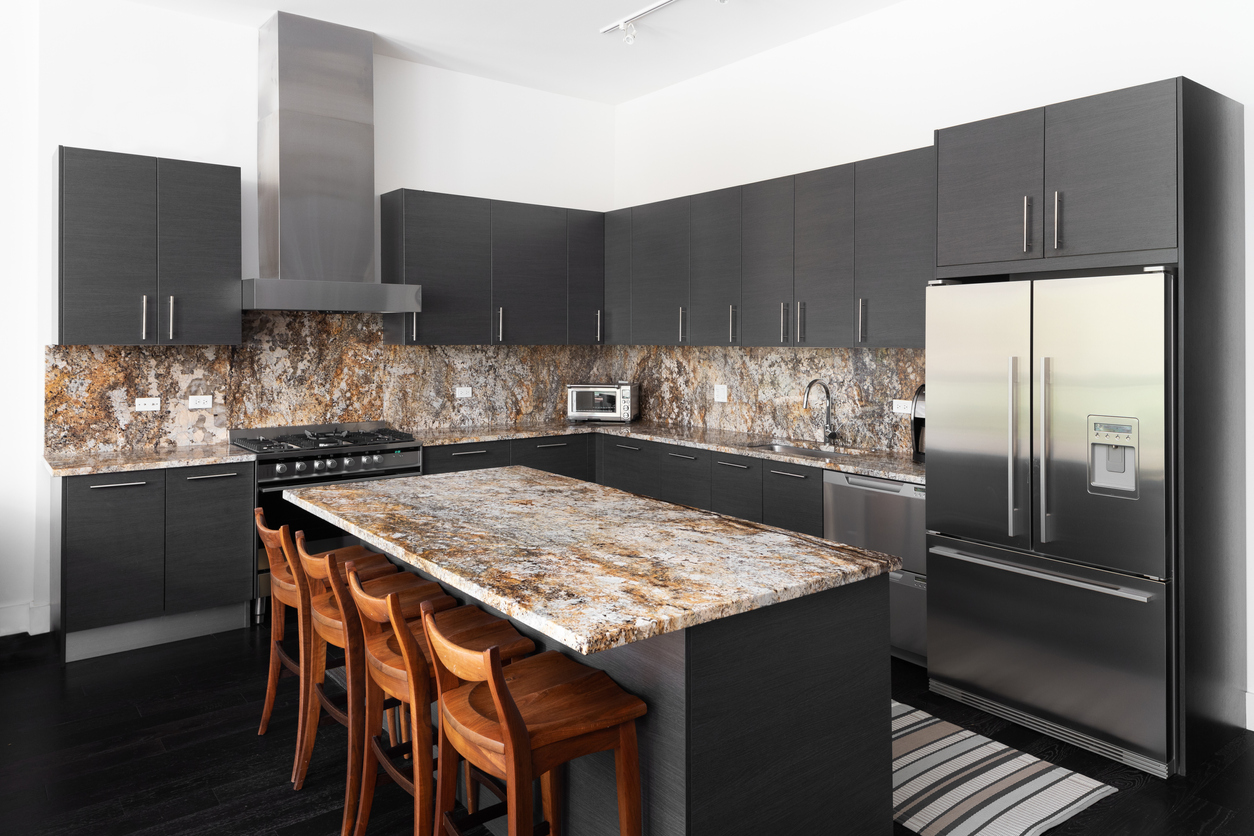
LLike quartz, granite comes in an extensive range of colors and patterns. Granite is certainly beautiful to many, and, because it’s a natural material, every piece is unique. It is also among the most durable countertops, and putting a hot pan on a granite kitchen countertop is perfectly safe. It is also highly resistant to cuts or scratches.
There are a few drawbacks with granite. It is porous, so it needs to be sealed annually to prevent staining. Since it is very heavy, professional installation is recommended. Although not a common problem, natural fissures can cause weaknesses. As a result, the patterns offered are usually dense, which doesn’t suit all kitchen styles. Also, unlike quartz, there are no ‘plain’ solid colors in granite.
Giving guidance on the cost of granite kitchen countertops is difficult. Often it is more affordable than quartz though rare forms can command premium prices.
Best For: Large, traditional kitchens where granite’s natural beauty can be fully appreciated.
Price: $50 to $340 per installed square foot
Longevity: 100 or more years
3. Laminate

Laminate is usually one of the cheapest countertop materials available. Often referred to by the brand name Formica, because it’s the OG of laminate, it is constructed using a particleboard core with a laminate sheet glued to the outside. The laminate is made from paper or fabric fibers combined with melamine resin to make it strong and waterproof. In the past, laminate countertop materials had something of a poor reputation and were prone to surface peeling or swelling when wet. Thanks to modern adhesives and manufacturing techniques, these issues rarely occur unless the laminate is badly damaged.
And today’s laminate designs are truly exceptional. Nearly any color or pattern can be printed onto the laminate, so it can effectively mimic granite, marble, or wood grain, and is available in almost any color imaginable. This makes it easy to find a laminate countertop to pair with modern kitchen styles, retro designs, or traditional looks. It is relatively easy to saw and drill, and is comparatively lightweight, which makes it a very popular choice for DIY kitchen installations.
While it is easy to wipe clean, it doesn’t have the durability of quartz or natural stone. Hot pans should not be placed directly on the surface, and a cutting board should always be used to prevent surface scratching. While today’s laminates are quite tough, heavy impacts can chip the surface. Fortunately, repair and refinishing products are widely available.
Best For: Kitchen installations where budget is a major determining factor.
Price: $40 to $80 per installed square foot
Longevity: 15 to 30 years
4. Marble
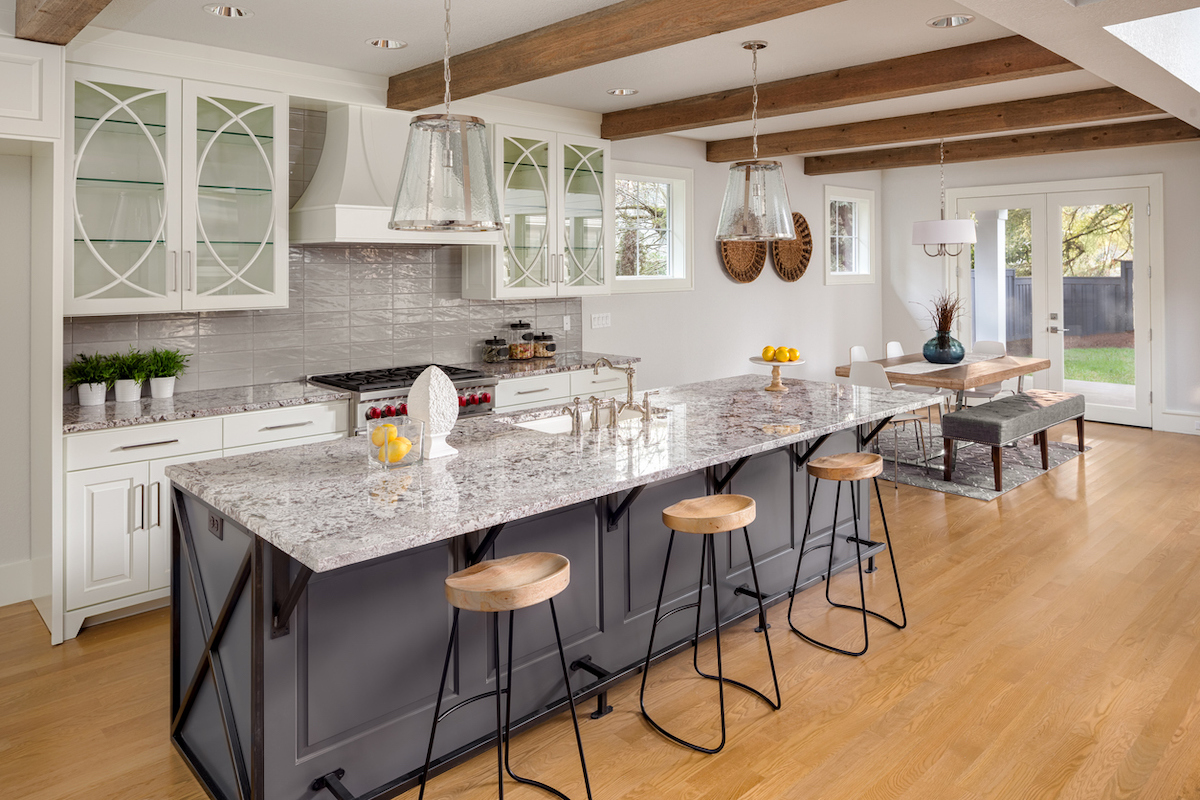
“I am a firm believer in natural stone. I feel like it has a beauty that can’t be replicated,” Ariana Lovato, owner and principal designer at Honeycomb in Pismo Beach, California. And there isn’t a material more luxurious or elegant in the kitchen than high-quality, marble countertops. Marble is available in a wide range of colors, and each piece has unique veining that invariably creates stunning impact. When treated with care, it can last for generations.
Marble is unaffected by the heat from hot pans or oven trays, but it is more porous than other natural stone countertops, and much less forgiving than quartz. While it will benefit from annual sealing to provide stain resistance, it is always a good idea not to let spills rest on the top for long. Liquids like wine, coffee, vinegar, and lemon and other acidic fruit juices can etch into the surface. Marble will also scratch fairly easily, although minor imperfections usually buff out reasonably well.
However, selecting marble can be more involved than other counter materials. “Typically, smaller marble samples are not available to see with other finishes at your home, you will need to take your cabinet, wall color, and flooring samples to the slab yard, making the process more difficult and time-consuming. Also, the lighting at the slab yard is typically not the same as the lighting in your home,” says Maynard.
Marble is undoubtedly one of the most desirable types of countertops for a high-end kitchen, but this beautiful material does require a considerable investment. It is even heavier than granite, and we recommend it only be installed by suitably experienced professionals.
Best For: High-end, luxury kitchens for cooks who will take the time to keep it looking its best.
Price: $55 to $390 per installed square foot
Longevity: 20 to 100 years
5. Butcher Block
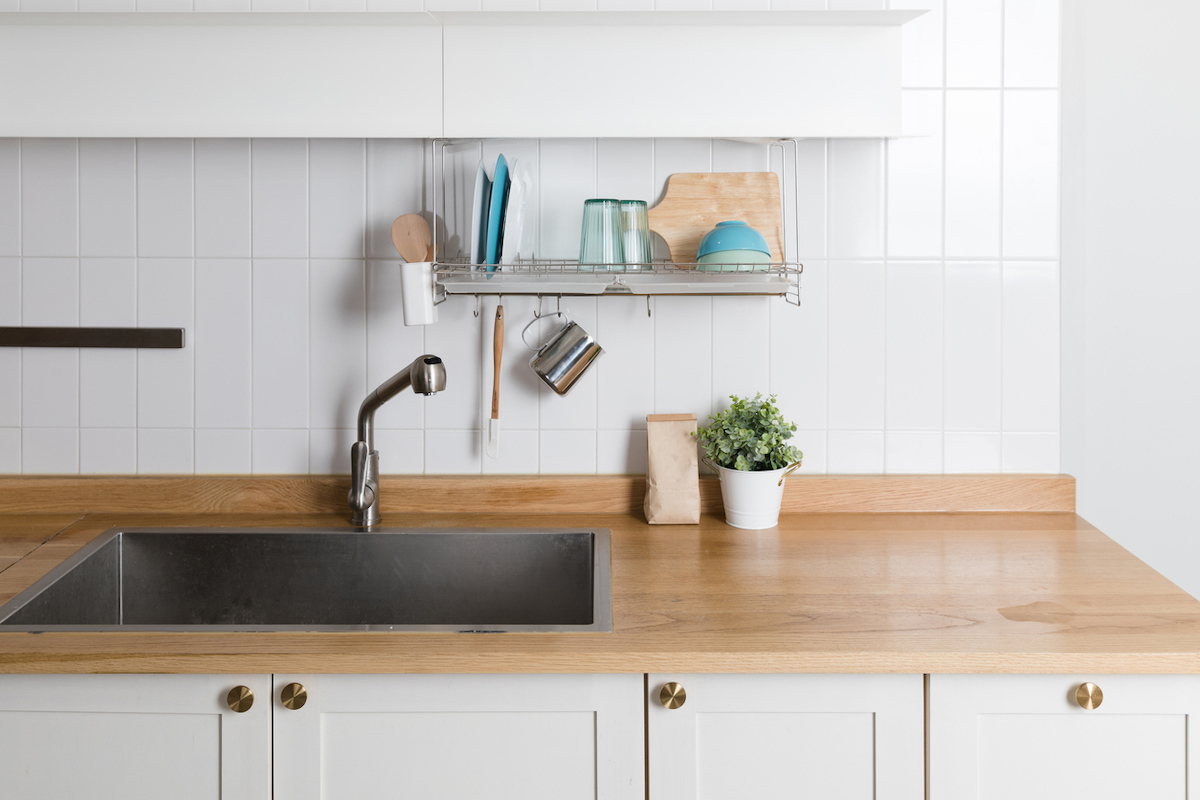
Butcher blocks take their name from their original use as a cutting surface for butchery. The wood blocks used in their construction are very good at absorbing the impact of heavy knives and cleavers, and the grain is—to some extent—self healing. Many woods are also naturally antibacterial and appeal to a sustainable home design.
“Environmentally conscious homeowners are preferring eco-friendly materials such as recycled glass and sustainable wood countertops, making them popular,” says Zagrodnik. “They align with the growing demand for sustainable building practices and also provide a unique aesthetic.”
Teak, which has natural protective oils, is sometimes used, though oak and maple are more common. These need regular oiling or sealing to protect the surface from stains. The type of wood will also have a major impact on price, which can vary tremendously.
Butcher block countertops are durable, but nicks and cuts will eventually make an impression. It is not difficult to sand out these marks, and refinish the surface, though many people simply accept small imperfections as part of the nature of the material. For those with restricted budgets, there are laminate versions that have the appearance of butcher block, but without the resilience.
Best For: Traditional, rustic, and farmhouse kitchens where a little wear and tear becomes part of the timeless charm.
Price: $90 to $350 per installed square foot
Longevity: 20 years
6. Soapstone
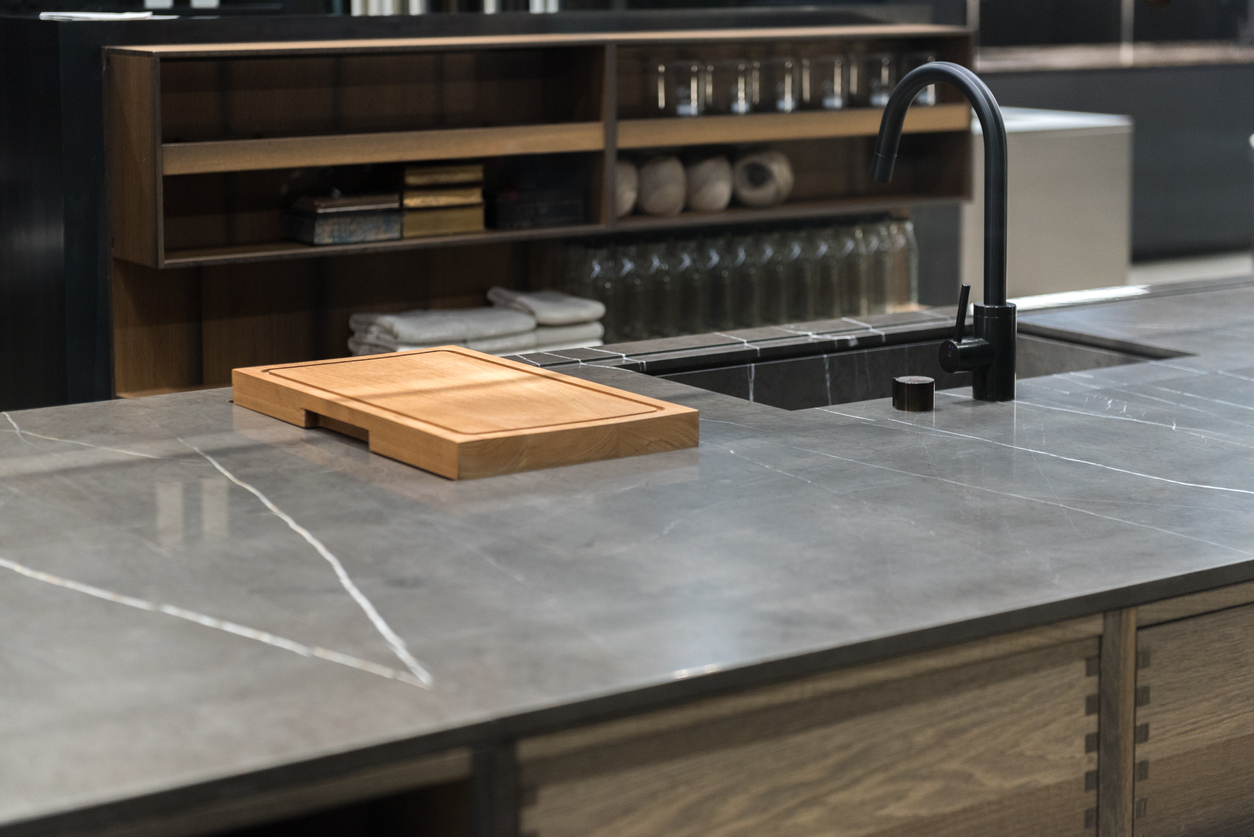
Soapstone may be one of the less common countertops for kitchens but this natural material is well worth considering, and it has proven history: Native Americans have used soapstone for cooking vessels and cutting boards for thousands of years. The predominant color is gray, though greens and blues are fairly common, and white and black can also be found. It often has veining much like marble.
There is a high percentage of talc in soapstone, giving it an unusual, almost soft feel, and hence the name. The surface oxidizes over time, developing a lustrous patina that adds to its appeal. Regular treatment with mineral oil helps to bring this out.
Soapstone offers good durability. “It is naturally non-porous, heat and stain resistant, and develops a rich patina over time, adding character to the kitchen,” says Zagrodnik. Since it has good stain resistance, soapstone doesn’t need to be sealed.
It is also naturally antimicrobial and completely unaffected by heat so hot pans will not leave marks. Although generally hard-wearing, it can scratch or abrade. Such marks can be buffed out, though doing so will affect the patina. Unless they are particularly obvious, they are usually best left alone.
Best For: Those who want the stain-resistance of quartz and the appearance of natural stone without the premium price of marble.
Price: $60 to $270 per installed square foot
Longevity: 20 years or longer
7. Terrazzo
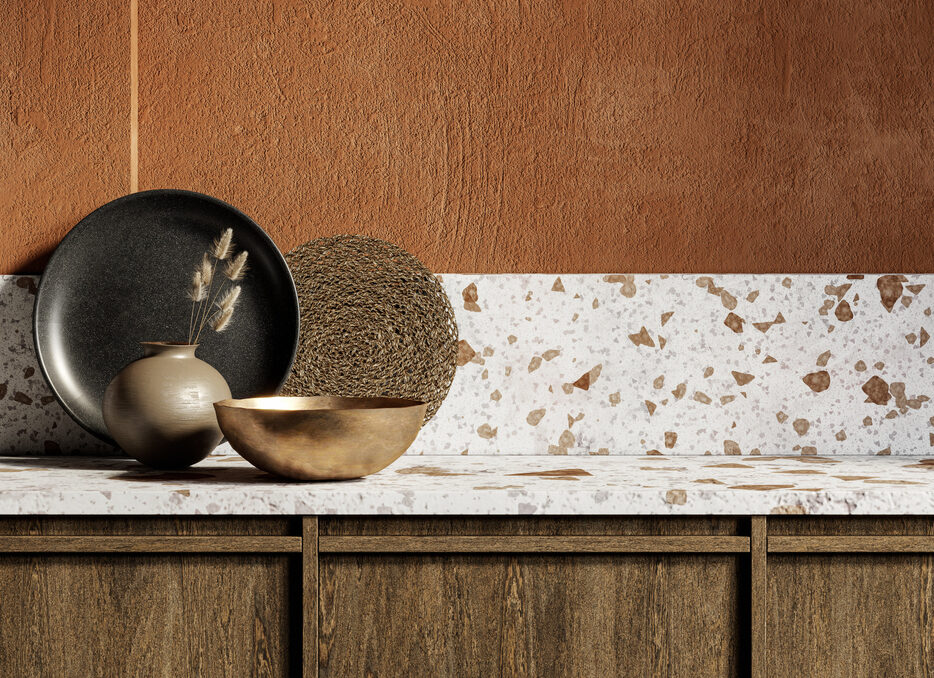
Terrazzo might sound like a surprising countertop material pick, even though it can actually trace its origins to mosaic workers in 16th century Italy where it began as a flooring material. It can be made from chips of granite, marble, or quartz, and may also contain glass or metal fragments. These are bound with cement and resin, and may be polished to a high shine. This amalgam means Terrazzo looks unlike any other material.
While the trend for Terrazzo as a kitchen countertop material is new, it has some clear benefits. It has the durability associated with quartz, but is frequently less expensive. It is nonporous so it won’t stain, and it is highly resistant to heat. It is very tough, and also UV resistant so it won’t fade if used as an outdoor countertop material.
“We are seeing a return to tiled countertops (I can’t believe I’m saying it!) but I’ve seen some really beautiful installations of tiled countertops in overseas publications, whether it’s a small 4×4-inch or even terrazzo tiles,” says Lovato.
The use of recycled materials, and the lack of toxic volatile organic compounds means Terrazzo also has more eco-friendly credentials than many alternatives. The appearance won’t appeal to everyone, but the only real drawback with Terrazzo is that it can crack if not correctly installed, and it’s very difficult to repair.
Best For: Those looking for something a little different that offers an alternative to quartz or natural stone.
Price: $460 to $810 per installed square foot
Longevity: 75 years
8. Stainless Steel

Stainless steel has long been considered the best countertop surface for professional chefs. The sleek, industrial look is used in commercial kitchens around the world because it is easy to maintain high levels of hygiene, and it offers outstanding durability. It is stainless by name, stainless by nature, resistant to mold and mildew, and easy to wipe clean. It is completely impervious to heat or liquids.
All of these benefits make stainless steel the countertop of choice among keen amateur chefs who would rather concentrate on preparing fine food than looking after the kitchen. The natural oils in fingerprints do leave marks though they do no damage, and require little effort to remove. The surface can be scratched but most see this simply as evidence of the kitchen being well used.
Best For: Enthusiastic cooks who favor a kitchen focused on hygiene and culinary excellence.
Price: $70 to $225 per installed square foot
Longevity: 20 years
9. Solid Surface
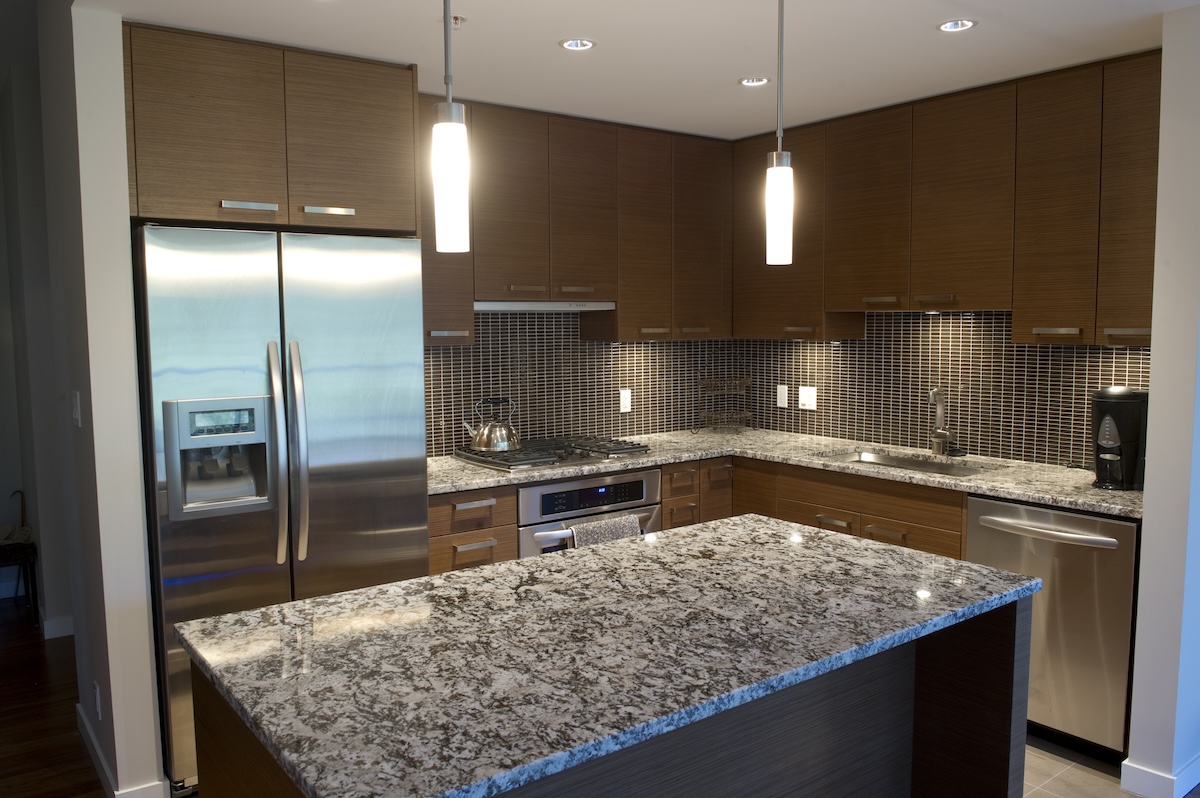
While solid surfacing had its heyday in the 1990s and early 2000s, it’s still a popular choice for its consistent look, variety of colors offered, and ability to mimic natural stone. “Some National Kitchen and Bath Association members also prefer solid surface materials for their seamless appearance and repairability,” says Zagrodnik.
Since it is a soft material, it can scratch more easily than natural stone. However, dents and scratches can be sanded and repaired because it is composed of a consistent solid composite throughout. It’s not heat resistant and it’s nonporous. It tends to be more affordable than natural stone, but more expensive than laminate.
Created in 1967 by DuPont, the first solid surface brand was Corian. And to this day, the category of solid surfacing is often referred to as Corian. Still, there are several brands that make a solid surface including Formica and Wilsonart.
Best For: Budget-conscious buyers who want a seamless look that can be easily repaired.
Price: $60 to $275 per installed square foot
Longevity: 20 to 30 years
10. Porcelain
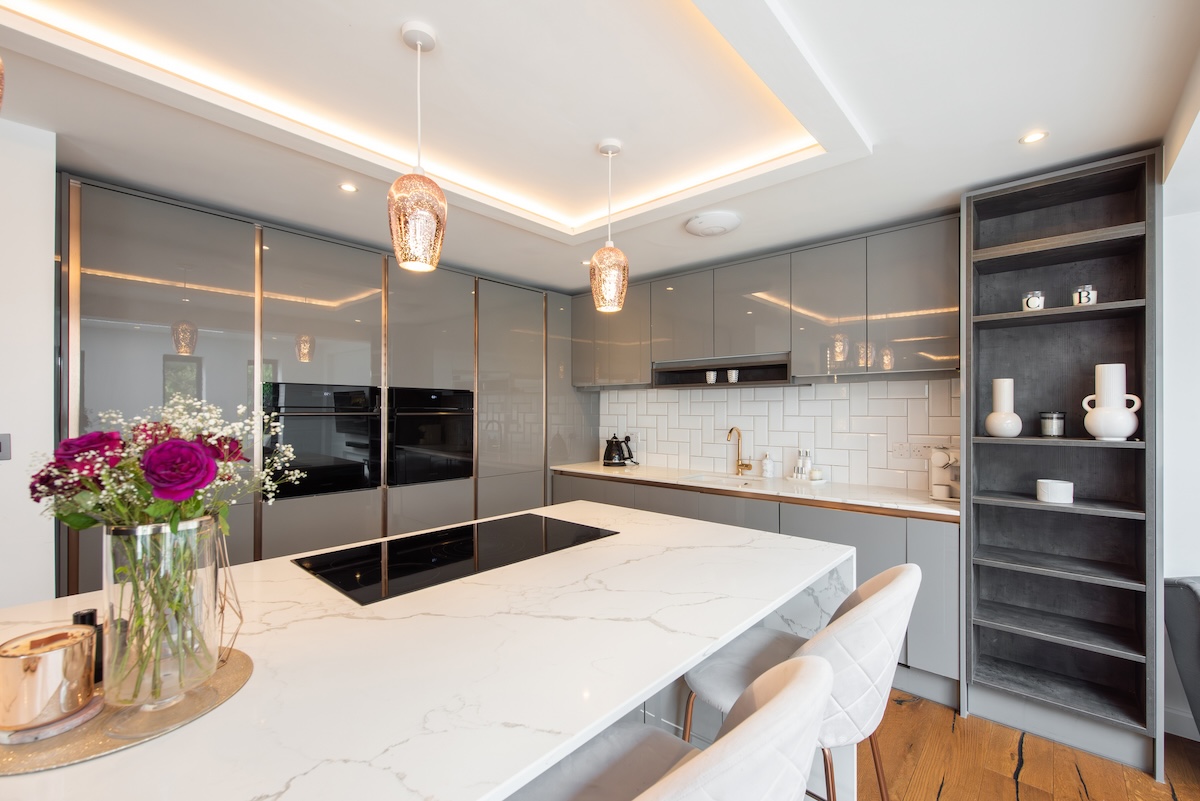
The fastest growing countertop trend is porcelain. A durable material, it’s also reasonably priced and appeals to a luxe modern aesthetic. “They are ideal for modern, minimalist kitchens because of their ability to be fabricated in ultra-thin profiles,” says Zagrodnik. But more than just for the look, “porcelain slabs are gaining popularity due to their heat resistance and UV stability.”
“Porcelain slab tops have also become popular, especially for those who want to incorporate invisible cooking technology under the countertops,” says Capra. “However, this type of slab has so many great design capabilities–beyond just countertops and backsplashes. It can be used for cladding cabinets and creating furnishings, such as a dining table, and provide a great surface for invisible induction cooking.”
And Maynard adds: “Porcelain is a great option for indoor or outdoor countertops. These work extremely well, especially for exterior kitchens and cabanas.” However, Capra warns: “With this material (and any countertop surface) working with a qualified installer is key.”
Best For: Cooks who want an integrated cooktop or a minimalist look.
Price: $43 to $228 per installed square foot
Longevity: 50 years or more
11. Quartzite

While some may use quartz and quartzite interchangeably, they aren’t the same. Quartzite is a natural stone. Quartz is engineered stone. So where it’s possible to control the look of a quartz countertop, it’s not possible to control Mother Nature.
“Quartzite is a very good choice if you love the beauty of natural stone,” says Capra. “It’s quite durable, and there is a wide array of options—some with strong, bolder veining, and others with softer, more subtle looks. There are other quartzites in a variety of stunning blues, greens, and rust tones.” She also says that leathered finishes and honed finishes are very popular right now, too.
Like other natural stones, quartzite needs to be sealed every 6 to 12 months .And cleaning up spills quickly with mild soap and water is a must in order to avoid staining the surface. It’s also more expensive than quartz to install, since it is a natural stone.
Best For: Those who want a natural countertop that has a variety of color choices.
Price: $95 to $275 per installed square foot
Longevity: 100 years
